The Battle of the P67 Boards - ASUS vs. Gigabyte at $190
by Ian Cutress on January 20, 2011 4:15 PM EST- Posted in
- Motherboards
- Gigabyte
- Asus
- P67
Board Features
| Gigabyte P67A-UD4 | |
| Market Segment | Performance |
| CPU Interface | LGA 1155 |
| CPU Support | i3/i5/i7 Sandy Bridge |
| Chipset | P67 |
| Base Clock Frequency | 80 MHz to 200 MHz in 0.1 MHz increments |
| DDR3 Memory Speed | 1333 MHz by default, 800-2133 MHz supported |
| Core Voltage | Auto, 0.750V to 1.700V in 0.005V intervals |
| CPU Clock Multiplier | Dependant on CPU |
| DRAM Voltage | Auto, 0.90V to 2.60V in 0.020V intervals |
| DRAM Command Rate | Auto, 1N to 3N |
| Memory Slots |
Four 240-pin DDR3 DIMM slots in dual-channel Regular unbuffered DD3 memory Up to 32GB total supported |
| Expansion Slots |
2 x PCI Express 2.0 x16 slots (PCIe 1 operates at x16 in single mode, PCIe 2 operates at x8 in single mode, or x8/x8 in dual) 3 x PCI Express 2.0 x1 slots 2 x PCI slots Supports ATI Crossfire Supports NVIDIA SLI |
| Onboard SATA/RAID |
a) 2 x SATA 6.0 Gb/s ports (white) supporting RAID 0, 1, 5 and 10 b) 4 x SATA 3.0 Gb/s ports (black) supporting RAID 0, 1, 5 and 10 c) 2 x eSATA 3.0 Gb/s ports from Marvell 88SE9128, RAID 0, 1 a) + b) are capable of cross channel RAID 0, 1, 5, 10 |
| Onboard |
4 x SATA 3 Gb/s w/ RAID 2 x SATA 6 Gb/s w/ RAID 2 x eSATA 6 Gb/s w/ RAID 1 x Front panel audio header 1 x S/PDIF Out header 3 x USB 2.0/1.1 headers 1 x USB 3.0/2.0 header via Renesas (NEC) D720200 chip 1 x Serial port header 1 x Clearing CMOS jumper |
| Onboard LAN | Gigabit Ethernet via Realtek RTL8111E |
| Onboard Audio | 7.1 channel Realtek ALC892 codec |
| Power Connectors |
24-pin EATX Power connector 8-pin EATX 12V Power connector |
| Fan Headers |
1 x CPU fan header 2 x System fan headers 1 x Power fan header |
| I/O Panel |
1 x PS/2 keyboard/mouse port 1 x Coaxial S/PDIF Out connector 1 x Optical S/PDIF Out connector 8 x USB 2.0/1.1 ports 2 x USB 3.0/2.0 ports via Renesas (NEC) D720200 chip 2 x eSATA 6Gb/s ports 1 x RJ-45 port 8-channel Audio I/O ports |
| BIOS Revision | F7 Beta |
In the Box
- I/O shield
- SLI 3-slot bridge
- 4 x right-angled SATA connectors
Compared to the ASUS P8P67 Pro, both boxes do not come with much in the way of extra peripherals. Here we get an SLI 3-slot bridge (compared to the 2-slot on the ASUS) but lose the USB 3.0 rear bracket, meaning that one will have to be obtained in order to use the USB 3.0 header on the Gigabyte board.
Software
Smart 6
Smart 6 tries to encapsulate a good portion of the myriad of software available in easy-to-use quick buttons, and is essentially identical to the X58 and P55 iterations of the software. The QuickBoot portion attempts to speed up boot times by bypassing the lengthy BIOS post, assuming there has been no physical hardware change. QuickBoost is a single screen overclocking utility, similar to the EasyTune6 front page. Recovery2 helps roll back the system to a previous set of settings without predefinition of a backup time flag, and also the TimeLock, which is almost superfluous given Windows7 has Parental Controls.
The idea behind TimeLock is similar to that on the Xbox360 parental controls – specify a certain number of hours per day (in this case, two different values for weekdays and weekends) for which the computer can be in use.
@BIOS
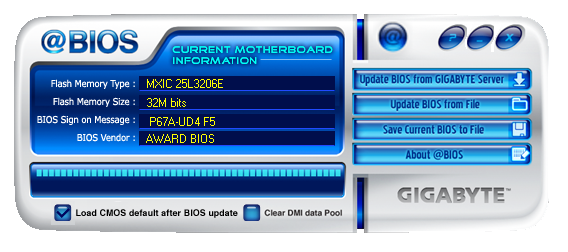
@BIOS is the staple Gigabyte BIOS update utility, and has been for a few iterations now. Users should note that to flash the latest BIOS files, the version of @BIOS on the CD is insufficient, and @BIOS 2.1 is required. 2.1 can be downloaded from the Gigabyte website.
Dynamic Energy Saver 2
Another program that Gigabyte has been using on various chipsets is the Dynamic Energy Saver 2. As you can see from the picture, various power saving features can be enabled or disabled through user settings, or you can let the software determine the best course of action.
EasyTune6
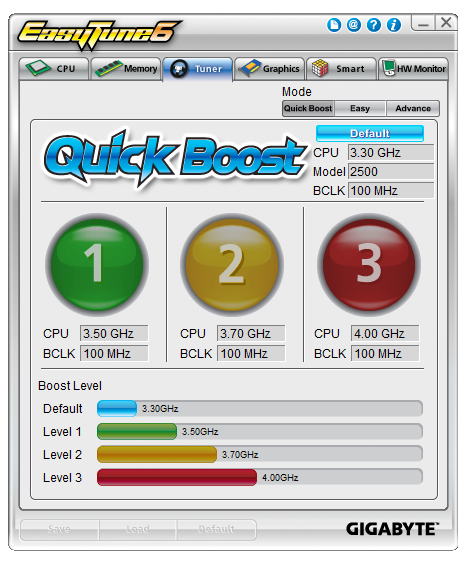
The OS overclocking tools are predominantly housed in EasyTune6. The front screen has those easy to use OC buttons, but only having three up to 4 GHz is somewhat limiting on the Sandy Bridge platform, given that most processors will happily do 4.4 GHz plus. There is no system of auto-overclocking detection similar to the ASUS boards.

Despite the software having an option for ‘real time ratio change’, of which there is an option in the BIOS to enable/disable, I could not get this to work. Upon setting a new multiplier, I was asked to reboot to apply it.
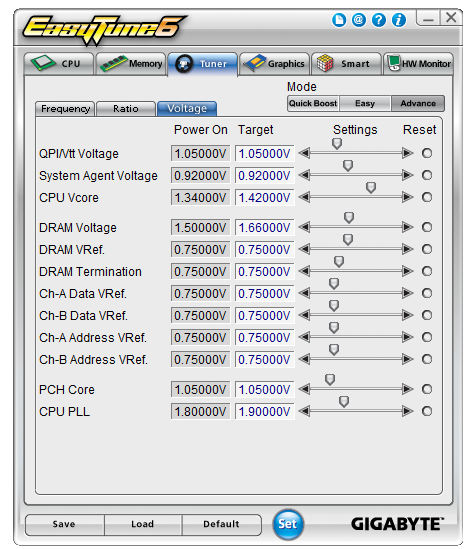
As always with EasyTune6, going to advance mode allows voltage manipulation. While it is nice to have such a wide variety of options, given that for Sandy Bridge all you really need is CPU VCore, DRAM and CPU PLL, it would have been easy just to include those in the ‘easy’ mode.

Fan control is basic in EasyTune6. Even in advanced mode, as shown above, you can choose where to put the initial and final ramp positions in terms of temperature against max RPM, but there is no option to define further points on the curve, or no determination of separate fans, so all chassis fans will be controlled by this one profile.



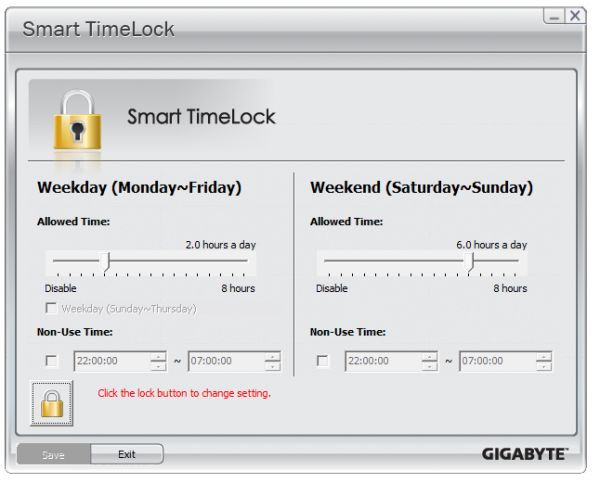
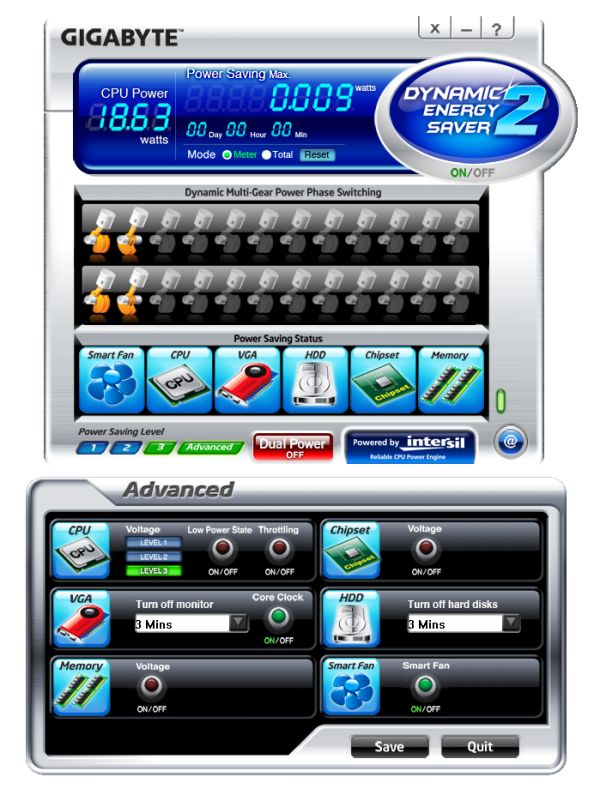








137 Comments
View All Comments
IanCutress - Thursday, January 20, 2011 - link
Long term usability isn't something that's easily tested. Sleep and hibernate is simple to test, but leaving the board on for a week? We unfortunately a) do not have enough hardware to keep the mu;tiples of same test bed and test other products at the same time, and b) if something did go wrong after a long sleep state, how long it would take to get in a different BIOS and re-run the test, or if a new BIOS had been released during the test, the test would have to be restarted. It's not a case of this being ignored by review sites, it's just not an applicable use of time, effort, and sustainability. If this is a major concern to you, then I'd suggest holding back until the next revisions of these boards hit the shelves - by that point, issues would be worked out and there would be a plethora of threads on the vendor's website describing various long term usability issues. There are always niche situations which could be looked at in more detail, and if you're up to the task, join a review website or start your own to tackle these issues specifically.Ian
strikeback03 - Friday, January 21, 2011 - link
Not to say your experiences are isolated (as I have an ASUS board that doesn't like one peripheral when resuming from sleep) but Gigabyte boards can have problems as well. I built a system for work using a P45 Gigabyte board that cannot run for more than 4 days, it just locks up after that.scott967a - Thursday, January 20, 2011 - link
Could you throw an MSI board into the mix?VahnTitrio - Thursday, January 20, 2011 - link
I had to order that ASUS board with basically no reviews available. Looks like I made a solid choice, as I got it for $165. I'm hoping it's waiting for me when I get home from work.landerf - Thursday, January 20, 2011 - link
Does anyone have a break down of what usb/sata controllers each asus model uses?ValueDriven - Thursday, January 20, 2011 - link
Thank you for this article. For me very timely w.r.t. general sandy bridge and ASUS specifically.I recently grabbed an i5-2500K at Microcenter for $192 after-tax, and bundled with an ASUS P8P67 (not PRO, Crossfire only) for another $127 after-tax. For a total of $320. Now all I need is some DDR3 memory and I'll have the missing components for my new build (non-gamer). So for about $375-$400, I'll have for once the basis of a mid-level enthusiast build with the latest technology and over-clockable in the high 4-5GHz range. (I usually trail the technology, letting it "depreciate." Hence, ValueDriven.)
I've had mixed results, but generally good, with ASUS boards. Long ago I had an ASUS P2B-F (i486 I think, PENTIUM III - 750MHz) which seemed pretty good and lasted a long long time.
Next I had an ASUS A7N8X Deluxe (AMD Athlon) board which was OK, although it did finally fail. I only hated it relative to the ABIT NF-7S board I got for a 2nd setup which oc'd a lot better, taking my Athlon from a native 1460MHz up to about 2220MHz..
Most recently I have an ASUS P5 Deluxe WiFi-AP (with a Core2 Quad 6600) which I got on clearance when CompUSA folded (to become kids 'puter). I really can't complain about this board. In fact, it has been great. The only thing it hasn't done is oc my Q6600 as high as I'd like, but I believe this is the fault of my TUNIQ Tower120 which has a crappy mount (press fit screw retainer heads popped off during installation - requiring torch & hammer repair). If I keep this Q6600 setup, I'll probably install a new heatsink...maybe a SCYTHE Mugen 2 w/ double fans which is sitting in the closet. But then I need to get a cooler for the i5-2500k! :(
The only GIGABYTE board I have, a GA-EP45-UD3R, I have never used. I bought it and an INTEL Q9550 for a new build which I'm probably going to skip & resell the parts. But I did buy it b/c I had heard good things about this board. (Mugen was originally for this setup.)
SO for me the real question is: Is it better to keep the Sandy Bridge setup & part out either my unused Q9550 setup or my used Q6600 setup, OR is it better to return the Sandy Bridge and just build my Q9950? The jury is still out!
darckhart - Thursday, January 20, 2011 - link
It's not really value driven if you don't use the parts you buy... it's just a loss. that continues to depreciate.wrt your situation, move forward with the sandy bridge since you have it already. at 4.5+ GHz, and new board features like usb3 etc, it's already loads better than a q9550 oc and p45 chipset.
strikeback03 - Friday, January 21, 2011 - link
I'd have to check, but I believe that is the same processor and motherboard I referenced above. In which case I couldn't recommend it unless you naturally shut the computer down daily or similar. We have it set up next to a stock-clock Q6600/P35 system and the student using them says the Q9550 feels faster, that said if overclocking you probably won't be able to tell much of a difference and the newer parts would probably get you more money back. the i5 is going to be a lot faster.DaveSimmons - Thursday, January 20, 2011 - link
Do any of the three support Dolby Digital Live real-time encoding of game audio as 5.1 for the optical digital port?I'm using analog outs for my socket775 system but may be switching to optical digital for my next build.
ajp_anton - Thursday, January 20, 2011 - link
You should've benchmarked the LAN connection. Is there any difference between Intel and Realtek?